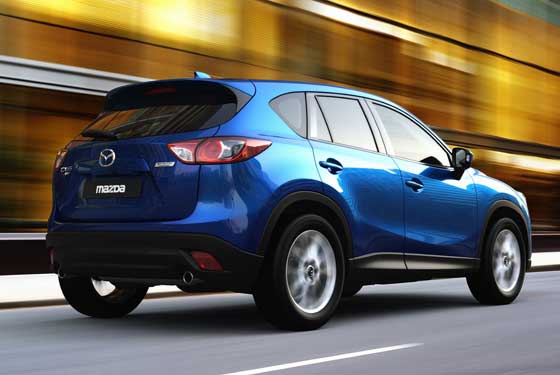Mazda’s all-new CX-5 is the first new model to feature the manufacturer’s breakthrough SKYACTIV Technology that will deliver major fuel savings and emission reductions for fleets. As a result, the Mazda CX-5, which made its world premiere at the Frankfurt International Motor Show, promises major wholelife cost savings for fleet operators and significant financial benefits for company car drivers over rival models.
- All-new Mazda CX-5 compact crossover SUV heralds future product strategy
- New technology delivers on Mazda’s ‘driving pleasure for all’ philosophy
- SKYACTIV Technology supports delivery of Mazda’s environmental objectives
- Application of new technology promises 30% global average MPG increase by 2015
The Mazda CX-5, which will go on UK sale in 2012, is powered by a range of new powerful yet fuel-efficient, low emission petrol and diesel engines. With fleet and personal budgets continuing to be under the microscope in a challenging economic climate, the Mazda CX-5 will deliver financial benefits, while retaining the distinctive Mazda fun-to-drive characteristic.
For fleet decision-makers and company car drivers the benefits will be reflected in lower vehicle operating costs, reduced fuel bills and savings in vehicle-related taxes; including capital allowances, Vehicle Excise Duty, Class 1A National Insurance contributions for businesses and benefit-in-kind tax for drivers.
The engine line-up will include Mazda’s 165ps SKYACTIV-G 2.0 petrol engine and SKYACTIV-D 2.2 diesel engine, which will be available in 150ps and 175ps versions. Each engine has a record-breaking compression ratio of 14:1 for enhanced efficiency.
Mazda’s engineers focused on achieving exceptional environmental performance for a compact SUV and targeted CO2 emissions of less than 120g/km for the 2WD SKYACTIV-D 2.2 Mazda CX-5. The 150ps derivative has a CO2 emissions figure of just 119g/km and combined cycle fuel economy of 62.8mpg*. Meanwhile, the SKYACTIV-G 2.0 petrol engine has a CO2 emissions figure of 139g/km and combined cycle fuel economy of 47.1mpg*.
The Mazda CX-5 features the full range of SKYACTIV Technology including improved aerodynamics, vehicle weight reduction, chassis developments and new manual and automatic transmissions matched to the new engines.
By 2015 Mazda is planning to deliver a 30 per cent improvement on the 2008 average fuel economy of vehicles and 23 per cent improvements in CO2 emissions. Crucially SKYACTIV Technology addresses the seemingly conflicting goals of driving pleasure and environmental and safety performance without compromise, with a significant role being played by progressive further refinement of petrol and diesel engine technology.
While Mazda continues to work behind the scenes on technological alternatives to the internal combustion engine, Mazda Fleet and Remarketing Director Steve Jelliss said: “SKYACTIV Technology will open new corporate opportunities for Mazda just as the recent addition of our fleet specific Mazda6 ‘Business Line’ model has done.”
The Mazda6 ‘Business Line’, priced at £18,300 on-the-road, has been specifically launched for fleets and company car drivers and is available as one highly specified model with Sanyo TomTom® satellite navigation, Bluetooth® technology and 17-inch alloy wheels. The 2.2-litre diesel five-door hatchback is forecasted to retain up to 36 per cent of its £18,130 P11D value at the benchmark three-year/60,000-mile threshold, significantly above the average for its direct competitor set.
Mazda’s strategy, as highlighted in its ‘challenging convention’ communications campaign, sees the brand defying current thinking that significant MPG / emissions breakthroughs can only be achieved through electric and/or hybrid technology with limited fleet applications and price premiums.
SKYACTIV TECHNOLOGY developments include:
- Improved petrol engine efficiency that delivers a 15% increase in MPG and torque
- New diesel engine technology to deliver a 20% MPG improvement
- New six-speed automatic transmissions to deliver a 4-7% MPG improvement
- Lightweight compact six-speed manual transmission to deliver improved MPG / emissions
- Next-generation body structures that are 8% lighter but 30% more rigid thus delivering fuel, emission and safety benefits
- 14% lighter chassis structure delivers further emissions benefits and improved ride quality
Jelliss added: “The Mazda CX-5 heralds the introduction of a portfolio of breakthrough technologies coupled with the gradual introduction of devices such as i-stop (Smart Idling Stop System), which will provide fleets and company car drivers with a winning combination of wallet-friendly motoring, driving pleasure and excellent environmental and safety performance.”


